 Website:
Swan Analytical Instruments
Website:
Swan Analytical Instruments
Group: SWAN Systeme / Seres OL
Catalog excerpts
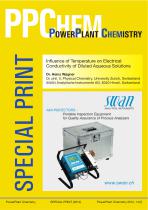
PPCHEM SPECIAL PRINT POWERPLANT CHEMISTRY PowerPlant Chemistry Influence of Temperature on Electrical Conductivity of Diluted Aqueous Solutions Dr. Heinz Wagner Dr. phil. II, Physical Chemistry, University Zurich, Switzerland SWAN Analytische Instrumente AG, 8340 Hinwil, Switzerland ANALYTICAL INSTRUMENTS AMI INSPECTORS Portable Inspection Equipment for Quality Assurance of Process Analyzers
Open the catalog to page 1
POWERPLANT CHEMISTRY PowerPlant Chemistry® Journal (ISSN 1438-5325) Publisher: Waesseri GmbH P.O. Box 433 8340 Hinwil Switzerland Phone: +41-44-9402300 E-mail: info@waesseri.com International Advisory Board: R. B. Dooley (Structural Integrity Associates, USA) M. Gruszkiewicz (ORNL, USA) Professor D. D. Macdonald (Pennsylvania State University, USA) M. Sadler (United Kingdom) R. Svoboda (Switzerland) H. Venz (Switzerland) Editor-in-Chief: Albert Bursik, Germany (editor@ppchem.net) Copyediting and Proofreading: Kirsten Brock, USA/Germany Graphics and Layout: te.gra – Büro für Technische...
Open the catalog to page 2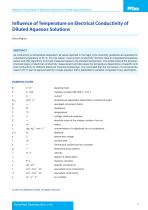
Influence of Temperature on Electrical Conductivity of Diluted Aqueous Solutions Influence of Temperature on Electrical Conductivity of Diluted Aqueous Solutions Heinz Wagner As conductivity is temperature dependent, all values reported in the major cycle chemistry guidelines are specified for a standard temperature of 25 °C. For this reason, most current conductivity monitors have an integrated temperature sensor and offer algorithms to convert measured values to the standard temperature. This article looks at the physical- chemical basics of electrical conductivity measurement and...
Open the catalog to page 3
Influence of Temperature on Electrical Conductivity of Diluted Aqueous Solutions INTRODUCTION The electrical conductivity of a dilute aqueous solution is a measure of the total amount of ionic solutes that are present. As a sum parameter, it provides an evaluation of the quality of boiler feedwater, and of the purity of the steam and the condensate. To ensure a safe and effective operation, the conductivity limits must be maintained. Normal operational values, as well as threshold values, are stated for the various sampling points of the water-steam-cycle (feedwater, boiler, steam,...
Open the catalog to page 4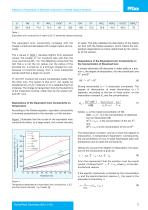
Influence of Temperature on Electrical Conductivity of Diluted Aqueous Solutions Table 1: Equivalent ionic conductivity in water at 25 °C (extremely diluted solutions). The equivalent ionic conductivity increases with the charge number and decreases with a larger radius and viscosity. The values in Table 1 deviates slightly from expected values: the smaller Li+ ion conducts less well than the more voluminous NH4+ ion. The difference comes from the fact that a is not the ion radius, but the radius of the solvated ion. A small ion or a strongly charged ion can, because of Coulomb energy,...
Open the catalog to page 5
Influence of Temperature on Electrical Conductivity of Diluted Aqueous Solutions As shown in Figure 2, the equivalent conductivity ⌳ is not an invariable quantity [4]. It decreases with increasing concentration and therefore the equivalent ionic conductivity must also decrease with increasing concentration, because all electrolytes depicted in Figure 2, apart from acetic acid (HAc), are strong, i.e., completely dissociated. The degree of dissociation of acetic acid decreases explicitly with increasing concentration. The decrease in the equivalent conductivity with higher concentration is...
Open the catalog to page 6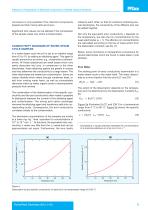
Influence of Temperature on Electrical Conductivity of Diluted Aqueous Solutions conclusion is only possible if the chemical components present and their mixing ratio are known. Significant limit values can be defined if the composition of the sample varies only within a limited extent. CONDUCTIVITY DIAGRAMS OF WATER-STEAM CYCLE SAMPLES In a water-steam cycle the pH is set at an alkaline range from 8.5 to 10, by adding an alkalizing agent. This agent is usually ammonia or an amine, e.g., morpholine or ethanolamine. All these substances are weak bases which only partly dissociate into ions....
Open the catalog to page 7
Influence of Temperature on Electrical Conductivity of Diluted Aqueous Solutions The relation of conductivity and temperature is unique for pure water. A certain temperature corresponds with a certain conductivity, and vice versa. Ammonia in Water Ammonia is a common alkalizing agent and it is dosed so that the required pH range is maintained. Ammonia NH3 is a weak base and dissociates in water to the degree ␣ into ammonium NH4+ and OH– NH3 + H2O Ǟ NH4+ + OH– Figure 4 shows the ion concentrations of NH4+ and OH– for a temperature range from 0 °C to 60 °C for three different overall ammonia...
Open the catalog to page 8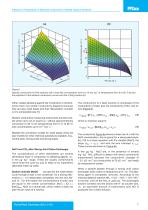
Influence of Temperature on Electrical Conductivity of Diluted Aqueous Solutions Figure 5: Specific conductivity for NH3 solutions with a total NH3 concentration from 0 to 10 mg · kg–1 at temperatures from 0 to 60 °C (a) and the projection of the isotherm conductivity curves onto the k-[NH3]-surface (b). Other volatile alkalizing agents like morpholine or ethanolamine have very similar conductivity diagrams because they are also weak bases and their dissociation constant is of a comparable size [7]. The conductivity of a NaCI solution is composed of the conductivity of water plus the...
Open the catalog to page 9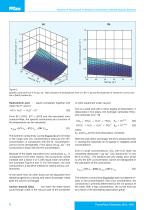
Influence of Temperature on Electrical Conductivity of Diluted Aqueous Solutions Figure 6: Specific conductivity of 0–50 µg · kg–1 NaCl solutions at temperatures from 0 to 60 °C (a) and the projection of isothermic curves onto the k-[NaCl]-surface (b). Hydrochloric acid water into H+ and Cl–. reacts completely together with From [H+], [OH–], [Cl–] = [HCl] and the equivalent ionic conductivities, the specific conductivity as a function of the temperature can be calculated: or other equipment under vacuum. CO2 is a weak acid with a minor degree of dissociation. It dissociates in two steps,...
Open the catalog to page 10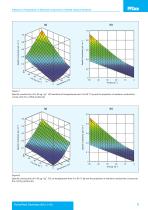
Influence of Temperature on Electrical Conductivity of Diluted Aqueous Solutions Figure 7: Specific conductivity of 0–50 µg · kg–1 HCl solutions at temperatures from 0 to 60 °C (a) and the projection of isotherm conductivity curves onto the k-[HCl]-surface (b). Figure 8: Specific conductivity of 0–50 µg · kg–1 CO2 at temperatures from 0 to 60 °C (a) and the projection of isotherm conductivity curves onto the k-[CO2]-surface (b).
Open the catalog to page 11All Swan Analytical Instruments catalogs and technical brochures
-
AMI ISE Universal
2 Pages
-
AMI Hydrazine
2 Pages
-
AMI Codes-II TC
2 Pages
-
AMI Codes-II
2 Pages
-
AMI CACE
2 Pages
-
AMI pH/Redox
2 Pages
-
An Introduction for Non-Chemists
19 Pages
-
Pautbac II
2 Pages
-
Opal
2 Pages
-
TOC Evolution VUV
2 Pages
-
Topaz Analyzer
2 Pages
-
Automated Quality Assurance
6 Pages
-
Seven Sins of Steam Sampling
16 Pages






















